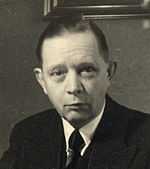Ernst Kretschmer
| Ernst Kretschmer | |
|---|---|
|
Ernst Kretschmer | |
| Born |
October 8, 1888 Wüstenrot |
| Died |
February 8, 1964 (aged 75) Tübingen |
| Nationality | Germany |
| Fields | Psychiatry |
| Institutions | Marburg University |
| Known for | Typology |
Ernst Kretschmer (October 8, 1888 – February 8, 1964), was a German psychiatrist who researched the human constitution and established a typology.
Life
Kretschmer was born in Wüstenrot near Heilbronn. He attended Cannstatt Hochschule, one of the oldest Latin schools in Stuttgart. From 1906 to 1912 he studied theology, medicine, and philosophy at the universities of Tübingen, Munich and Hamburg. From 1913 he was assistant of Robert Gaupp in Tübingen, where he received his habilitation in 1918. He continued as assistant medical director until 1926.
Kretschmer was the first to describe the persistent vegetative state which has also been called Kretschmer's syndrome. Another medical term coined after him is Kretschmer’s sensitive paranoia. This classification has the merit of singling out "a type of paranoia that was unknown" prior to Kretschmer, and which "does not resemble the stereotypical image [...] of sthenic paranoia".[1] Furthermore, between 1915 and 1921 he developed a differential diagnosis between schizophrenia and manic depression.
Kretschmer is also known for developing a classification system that can be seen as one of the earliest exponents of a constitutional (the total plan or philosophy on which something is constructed) approach. His classification system was based on three main body types: asthenic/leptosomic (thin, small, weak), athletic (muscular, large–boned), and pyknic (stocky, fat). (The athletic category was later combined into the category asthenic/leptosomic.) Each of these body types was associated with certain personality traits and, in a more extreme form, psychopathologies. Kretschmer believed that pyknic persons were friendly, interpersonally dependent, and gregarious. In a more extreme version of these traits, this would mean for example that the obese are predisposed toward manic-depressive illness. Thin types were associated with introversion and timidity. This was seen as a milder form of the negative symptoms exhibited by withdrawn schizophrenics. However, the idea of the association of body types with personality traits is no longer influential in personality theory.
In 1926 he became the director of the psychiatric clinic at Marburg University.
Kretschmer was a founding member of the AÄGP (General medical society for psychotherapy) which was founded on January 12, 1927. He was the president of AÄGP from 1929. In 1933 he resigned from the AÄGP for political reasons, but started to support the SS and signed the "Vow of allegiance of the professors of the German universities and high-schools to Adolf Hitler and the National Socialistic state."[2] He did not oppose the eugenic laws of Nazi Germany.
From 1946 until 1959, Kretschmer was the director of the psychiatric clinic of the University of Tübingen. He died, aged 75, in Tübingen.
Character styles
Kretschmer divided personality into two "constitutional groups": Schizothymic, which contain a "Psychaesthetic proportion" between sensitive and cold poles, and Cyclothymic which contain a "Diathetic" proportion between gay and sad. The Schizoids consist of the Hyperesthetic (sensitive) and Anesthetic (Cold) characters, and the Cycloids consist of the Depressive (or "melancholic") and Hypomanic characters.
Works
- Wahnbildung und manisch-depressiver Symptomenkomplexe, Berlin, (1914, dissertation) (development of delusion and manic-depressive symptom complex)
- Der sensitive Beziehungswahn, Berlin(1918), 2. Aufl. Berlin (1927), habilitation) (the sensitive relative delusion)
- Physique and Character (International Library of Psychology) (1931), Routledge, ISBN 0-415-21060-7
- Medizinische Psychologie, (1922) (medical psychology)
- Hysteria, Reflex, and Instinct, Leipzig (1923) Greenwood, ISBN 0-8371-5754-4
- Die Veranlagung zu seelischen Störungen, mit Ferdinand Adalbert Kehrer (1883–1966), Berlin (1924) (the disposition for psychic disturbances)
- Störungen des Gefühlslebens, Temperamente, Handbuch der Geisteskrankheiten. Band 1. Berlin (1928) (psychic disturbances and temperaments)
- The Psychology of Men of Genious (International Library of Psychology), Berlin (1929), Routledge, ISBN 0-415-21061-5
- Das apallische Syndrom, in Ztschr. Neurol. Psychiat, 169,576-579 (1940) (the apallic syndrome)
- Psychotherapeuthische Studien, Stuttgart (1949) (psychotherapeutic studies)
- Robert Gaupp zum Gedächtnis, Deutsche medizinische Wochenschrift, Stuttgart (1953) 78: 1713. (in memory of Robert Gaupp)
- Gestufte Aktivhypnose - Zweigleisige Standardmethode, In: V. E. Frankl, V.v. Gebsattel and J.H. Schultz, Hrsg.: Handbuch der Neurosenlehre und Psychotherapie, Band IV, pp. 130–141. Urban & Schwarzenberg, München-Berlin (1959)
- Gestalten und Gedanken (1963) (characters and thoughts)
See also
Notes
- ↑ Miller, J.-A., in de Georges, P. (2012). "The Meaning of Krestchmer". Hurly-Burly 8: 161.
- ↑ (In German: "Bekenntnis der Professoren an den deutschen Universitäten und Hochschulen zu Adolf Hitler und dem nationalsozialistischen Staat" Ernst Klee: Das Personenlexikon zum Dritten Reich. Wer war was vor und nach 1945. Fischer Taschenbuch Verlag, Zweite aktualisierte Auflage, Frankfurt am Main 2005, S. 339.
References
- Ideology and ethics. The perversion of German psychiatrists’ ethics by the ideology of National Socialism. by L. Singer, Eur. Psychiatry 1998
- Un apercu sur la psychiatrie sociale allemande en 1934. by J. Bieder, Ann. Med. Psychol. 1996
- Priwitzer, Martin, Ernst Kretschmer und das Wahnproblem, (Ernst Kretschmer and the problem of delusion) Dissertation, 2004; published - Stuttgart: Franz Steiner, 2007, xiv + 314 S.
- Millon, T., Grossman, S., Millon, C., Meagher, S & Ramnath, R. (2004). Personality disorders in modern life (2nd edition). Hoboken: John Wiley & Sons, Inc.
- de Georges, P. (2012). "The Meaning of Kretschmer". Hurly-Burly 8: 149-168.
- Trizzino, A. (2014). "Il mondo nella testa. Sul delirio di rapporto sensitivo di Ernst Kretschmer". Comprendre. Archive International pour l’Anthropologie et la Psychopathologie Phénoménologiques 24: 217-224
External links
|
